Pallium India – through the eyes of a Nurse from Portugal
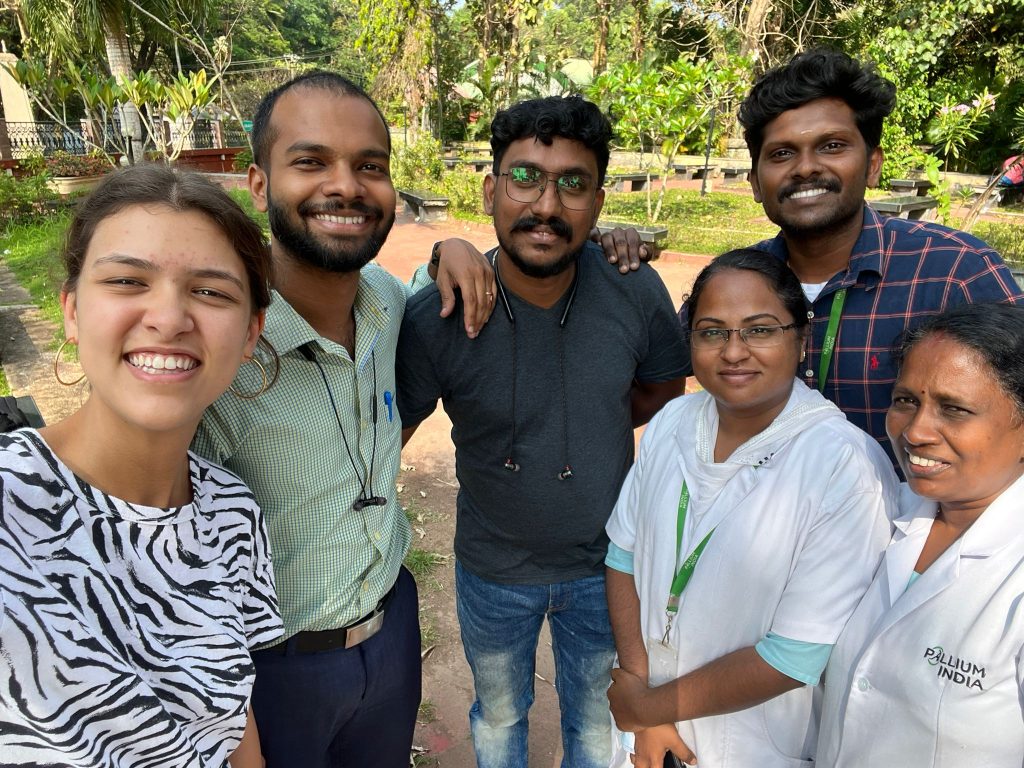
Rita Mascarenhas Pessoa writes:
One of my first thoughts after a few days at Pallium India was how much the Palliative Care world has to learn here. But I changed my mind, I think it’s much bigger than that. By the end of this text, I hope I’m able to make you feel the same way.
Located in Thiruvananthapuram, Kerala, Pallium India, a Non-Governmental Organization, started in 2003 with the work of Dr. Rajagopal. Prior to creating Pallium, Dr. Rajagopal had already founded the “Pain and Palliative Care Society”, which later became a World Health Organization (WHO) demonstration project. It’s important to say that none of this was a one man job, he had the help of many people, not only Dr Suresh Kumar and other healthcare professionals but also Asok Kumar, or as described in his book “Walk with the Weary”: “the first palliative care volunteer”. Asok reinforced the importance of having non-medical people in this type of projects, to reinforce humanity as a “defining touchstone”. To try and give a little more context, of someone who had been doing a beautiful work, Dr. Rajagopal also contributed to the amendment of the Narcotic Drugs and Psychotropic Substances (NDPS) Act, making access to pain relief a little easier in India (even though, as he concluded, there’s still a long way to go).
So if you’re like me, from a developed country (I’m from Portugal), you would probably think, seeing that we have more resources, our work would be better than the work done in India, a developing lower middle income country. This is where I tell you that you have never been so wrong your entire life. Pallium India has a big team, full of palliative care knowledge. Working for Monday through Saturday, they have doctors, nurses, physiotherapists, psychologists, social workers, volunteers, etc. They have 27 nurses, holding the majority of the team. They are one important backbone of Pallium India, which makes me think of how much my country still has to learn about the importance of nurses.
The Services
Pallium India has 4 types of palliative care services: In Patient Unit, Out Patient Unit, Home Care and TeleHealth. They have a project called Half Way Home for the rehabilitation of patients with, for example, spinal cord injury or cerebrovascular disease and a program called Vocation Therapy where they give resources to this patients so that they can work and earn some money. They have more or less 5000 patients, where 35% represent the patients doing rehabilitation (but still with palliative care needs) and the others divided between non oncological (40%) and oncological (60%) palliative care patients. They have 18 link centers (combined with Home Care and Out Patient Unit) and receive in all of their units adults and children.
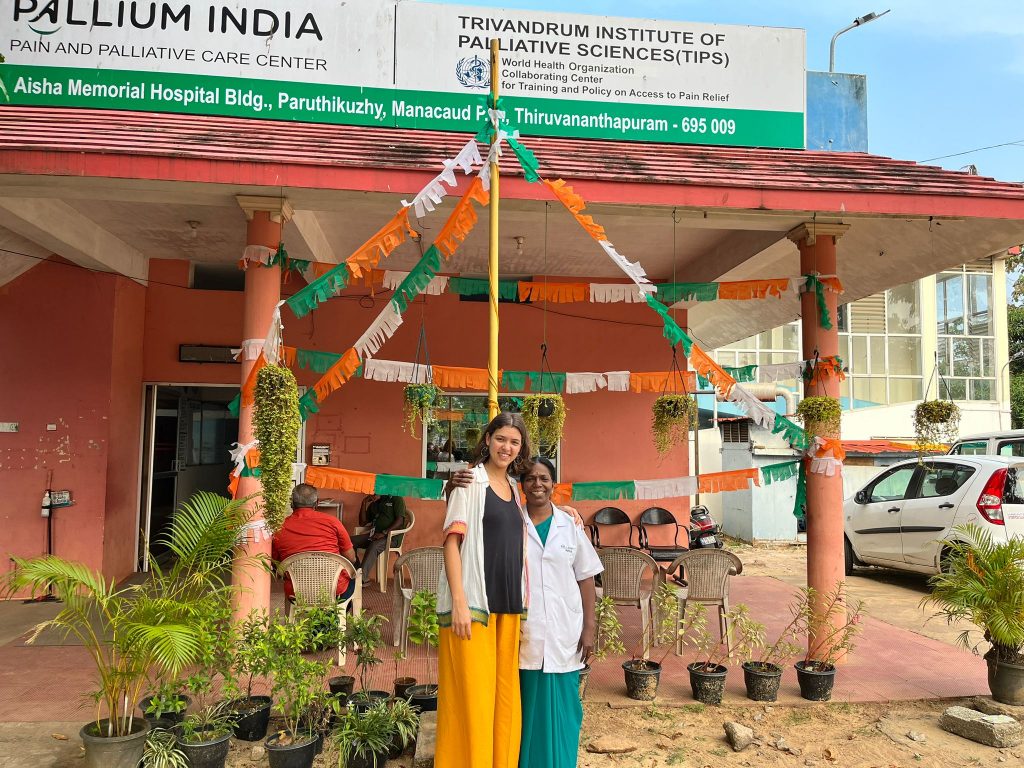
In the In Patient Unit they have 8 beds for patients (and another bed for the caregiver), 3 private rooms, dedicated to End of Life Care if needed and the Half Way Home, which has 2 rooms and a kitchen (everything equipped to help the patient and family adjust to their new normal with a wheelchair for example). They receive both adults and children patients.
The Out Patient Unit is where they receive patients and their families for consultations, and they have an Out Patient Unit at all of those link centers, making palliative care more accessible even to those who are very far away. The Home Care also does this job, connecting to the link centers and the community.
So all of this just gives a small notion of what they do here, this is the pragmatic view of all of it. Speaking from the heart, I believe I won’t be able to put in words how much I admire what they were able to develop here.
First few days & the Language Barrier
My first days with Pallium were spent at the In Patient Unit, where I was able to see excellent palliative care practiced. When we talk about health, the WHO has already stated it as: “(…) a state of complete physical, mental and social well-being and not merely the absence of disease or infirmity.” Unfortunately we all know that sometimes that view isn’t practiced in healthcare. But here I am, in India, and it really is the core of this institution. Every aspect of suffering is approached, whether spiritual, social, physical or emotional, by all the different elements of the team. It’s clear to see multidisciplinary and interdisciplinarity work, which is very enriching, especially for me because one of my team’s biggest difficulties is the need for more human resources in all healthcare professions.
I was curious to see here how they approach spiritual suffering, having a different culture from what I’m used to, I thought it might add me value. It did. I had a beautiful teaching moment (and also a humbling moment) when, in Home Care, a crying patient had the doctor sit in his bed in silence, with his hand on the patient’s arm. The patient had paraplegia related to spinal cord injury, but really wished to walk again. The doctor just stayed there, in silence, allowing the patient to feel and showing him, with no words, that he was there with him. A compassionate silence, a moment of peace filled the room.
My major difficulty here was related to the language barrier. Of course it’s obvious to conclude that I didn’t speak a tiny bit of Malayalam, but what started as a significant frustration actually transformed in a teaching opportunity. I would focus on the non-verbal communication and understand a lot of the patients’ needs, and, when in need of saying something, without words, I could give compassionate silence and also use the therapeutic touch. And yes, I know, we talk about this in nursing college and in palliative care, and even though I’m aware of this and I’ve been using this type interventions for quite some time, when you’re a bystander in a different culture, with different views, no words you can give, you start to really understand how powerful non-verbal communication and silence are. It strengthen my beliefs in this matter.
Care Beyond Cure
All the cars at Pallium India have the following sentence written: “Care beyond cure”. Very few words with a lot of power. In Dr. Rajagopal’s book, he also wrote: “Palliative care offers viable alternative to aggressive life support measures in advanced incurable illnesses. It is just a matter of giving the right medicines aiming at comfort and a bit of compassion so that they can start smiling, eating and drinking again, and eventually die a compassionate death. But that is possible only if the medical system as a whole understands palliative care.”
Even though many things in India and Portugal are different, we share more similarities than I thought related to health care. Pallium India has been walking on a path of palliative care education throughout India. I believe in Portugal all the palliative care teams have been trying to do the same, educate more and more about palliative care. Making sure palliative care and death literacy is available to a greater extent (either patients, families and other healthcare professionals). Although there’s still a long way to walk, being here makes me more optimistic than ever. All the link centers have had a boost of education related to palliative care, this makes it easier for the patients to get aware of Pallium India and its work.
Nowadays, in palliative care, we talk a great deal about compassion. Compassion seems to me one massive weapon to deal with high levels of pain (total pain) inflicted by an advanced incurable disease. Here, depending on the communities, Pallium India will do Home Care with the help of the volunteers. I would say I was able to witness the true meaning of Compassionate Community, and how much it benefits the patients. We would get to the city, either urban or rural area, and the volunteers would ride with us helping to get to the place of the patient. As you can imagine, GPS will not be useful, so the volunteers take of their time to help the vulnerable patients and families to get the care they need.
I asked how would a compassionate community start and Dr. Deepak explained to me in the most beautiful way possible. “You have to identify the person, everybody wants to do something good. Some only do for themselves, we called them selfish. Others only want to do it for their families, we called them responsible. And some want to do for their communities, we called them leaders.”
Caring for the Caregivers
Here, and this really is related to Indian culture, they have a more “detailed” view of the caregiver. I wouldn’t say in every case, but in most cases there’s always a caregiver. So patients would come to the In Patient Unit for caregiver teaching, seen that here is rare for a patient to be in other place that it’s not his/her home. When I explained how it worked a lot of the times in Portugal, they found it very sad that patients would die so alone in hospitals, not surrounded by their families or with a paid caregiver. Obviously it’s not the same everywhere, but we all know how much suffering and loneliness is walking around the hospitals and how urgent it is for us to do something about it.
Last, but not least, being at Pallium and reading “Walk with the Weary” also made me thought of the population in need of palliative care. Dr. Rajagopal talks about how he and his colleagues never stuck to traditional restrictive definitions of palliative care. He talks about the evolution of the concept, how it started with Dame Cicely Saunders caring for people dying with cancer and evolved to care to any enduring, life-threatening disease. “Today it is more widely accepted that palliative care should be available to anyone with serious health-related suffering, including a natural disaster like earthquake, as recommend in 2017 by the Lancet Commission on Global Access to Palliative Care. (…) While no palliative care team would think of discrimination in the name of age, sex or religion, here is a curious kind of discrimination – in the name of a diagnosis.”
Before coming to Pallium, this wouldn’t be so clear as it is now. How paraplegic patient, after a fall at a construction site, has so many palliative care needs and benefits in the long run to have a palliative care team to support him/her. That’s why Pallium India has an integration with the Neurology Department at Medical College Thiruvananthapuram.
I’m not saying with all of this, Pallium India is perfect, I’m not sure we can find something perfect when related to health care. But I do believe we can try, with all the adversities and imperfections, and Pallium India tries relentlessly. I’m lucky I was able to witness this amazing and beautiful work. You wouldn’t believe how much they give to patients living in poor conditions, not only resources but compassion also, and how grateful the patients and their families are. How, even in a big disparity of living conditions from my reality, here there’s always a smile from and for everybody. I believe only here one would be able to actually understand it fully.
To sum it up, and really sum it up because there’s a lot left to say, I would hope by now you’re as hopeful as I am. Hopeful that we can do more than we think and keep on this palliative care mission, trying to make palliative care accessible to every patient and their families, to give more education to all healthcare professionals as soon as possible. Doctors, nurses, physiotherapists, psychologist, social workers, all of them will deliver better care with the science, principles, resources and philosophy palliative care offers. “Cure sometimes, relieve often and comfort always”. I’m also hoping that you can now see. It’s not only the palliative care world that has a lot to learn from Pallium India, but actually the whole world!
Thank you Pallium India for this amazing opportunity which gave me so much as person and as a nurse.
(Rita is a Nurse in a Palliative Care Support Team, at Hospital Professor Doutor Fernando Fonseca, Portugal. She is finishing her thesis for her Masters on Palliative Care at Universidade Católica Portuguesa.)
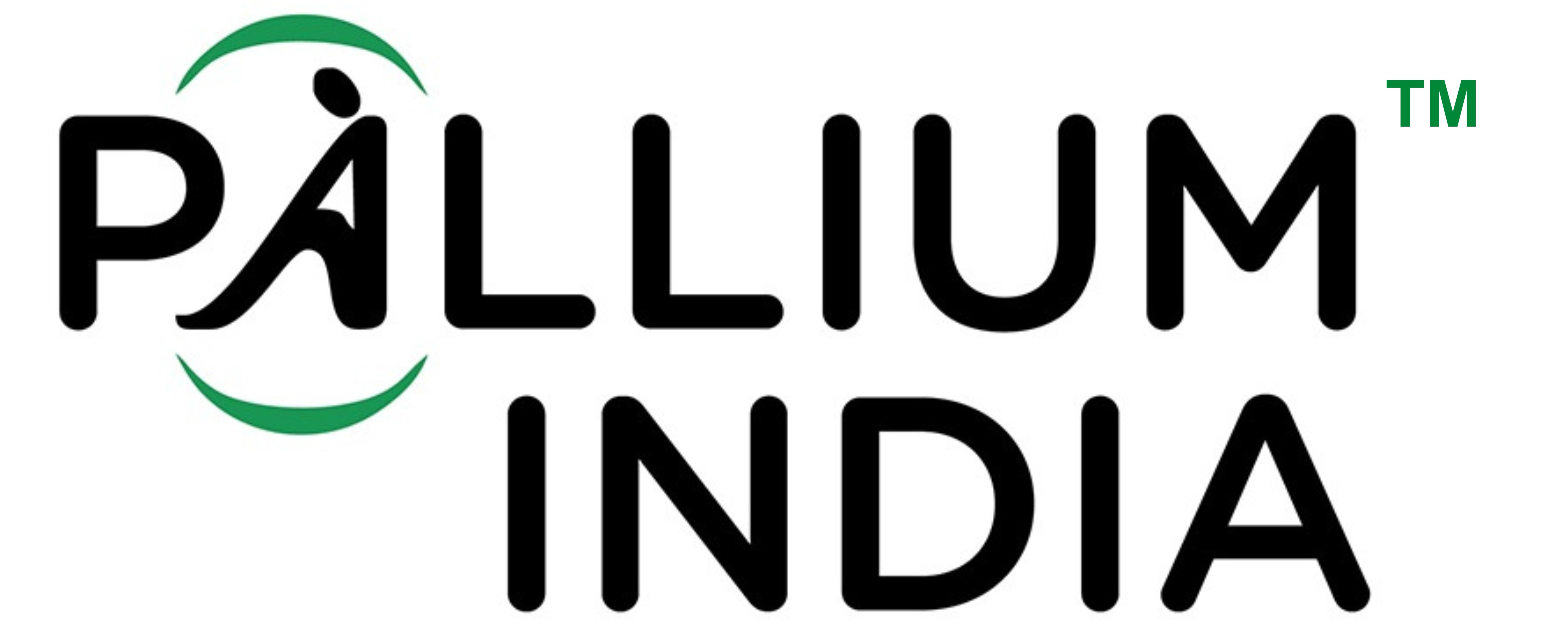
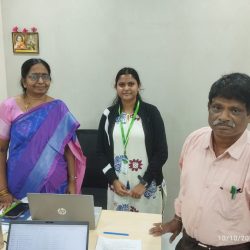

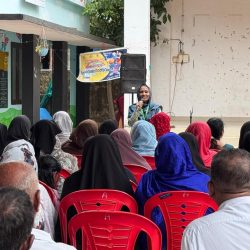

Wonderful experience sharing